You are planning the testing for an emergency product update required to correct a serious security issue and to improve system maintainability of a key product in your company's catalogue. It has been estimated that the historical cost to the company for the security issue in this system has been $375,000.
In the last year a total of 10 reported "live' incidents were reported, resulting in a total external failure cost of S110.000 to correct.
The cost of prevention for this project has been estimated as $78,500 and from the development you have learned that the average cost of detection was $1,250 and the average cost of internal failure was $7,450
Which one of the following statements about cost of quality is TRUE? SELECT ONE OPTION
A car rental company offers discounts to its customers based on a number of factors, including booking history, length of membership and type of car being booked. An update to the rental application is under test, with test cases written that specifically address a documented product risk covering discount calculation. Although the risk impact was analysed as high, the likelihood was given as low, as there had been no known changes to the calculation rules. However, during test execution some discount calculations were incorrect and investigation showed that code changes had been made that impacted the discount algorithms. As a result, the likelihood was increased to high by the risk management team.
Which would be the BEST measure to take to respond to the current situation?
You are the Test Manager for a critical system and are using a risk-based approach for this project.
Which of the following would most clearly convey the current status to project stakeholders? [3]
Which of the following metrics would be most beneficial to collect to determine the effectiveness of a review process? [2]
It is now the final day of the planned user acceptance test period and you are preparing the test completion report. Some defects have not been fixed and some tests have not been run; due to both these factors the exit criteria have not been met.
Which two of the following metrics will be most useful in helping the stakeholders to decide whether to allow the system into production?
Which of the following statements correctly describes a 'depth-first approach' to managing risk based testing? SELECT ONE OPTION
As a Test Manager, which one of the following do you think is the MOST important reason for ensuring effective processes are in place for test monitoring and reporting?
SELECT ONE OPTION
Which two items are MOST important for inclusion in your tool selection plan for batch-only performance testing?
Which two of the following activities would normally occur in the Acquisition stage of a tool's lifecycle?
a) Assign a tool administrator to decide on best use of the tool
b) Establish a backup and restore strategy for the tool
c) Review other tools provided by the same vendor
d) Determine how the tool may be impacted by a change to the operating environment
e) Develop and implement a training plan for new users of the tool
SELECT ONE OPTION
Which statement about defect management in hybrid software development is TRUE?
Which one of the following standards would a Test Manager be expected to understand when planning and organising activities with a Project Manager? SELECT ONE OPTION
You are the Test Manager for a project for a new entertainment booking system using Agile. The project’s objectives include:
Online response time must satisfy customers
Payments must be secure against fraud
In case of system failure, only transactions in progress can be lostWhich option meets all the criteria of the S.M.A.R.T. goal methodology?
You are writing the project test plan and are analysing the following risks in the project risk register:
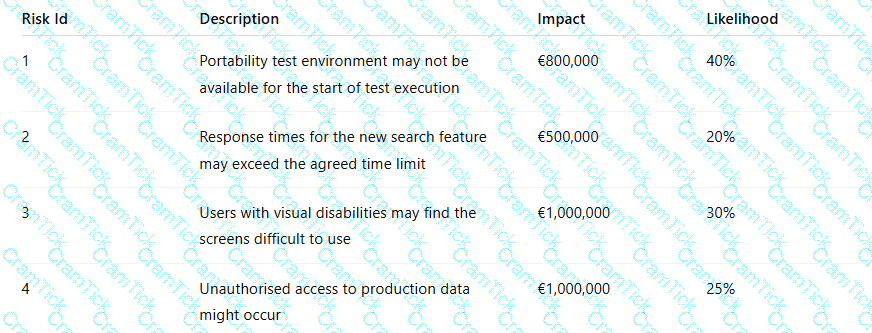
Which would be the MOST appropriate test activities to mitigate the product risks?
Which statement about defining process improvement actions using defect report information is TRUE?
Which two of the following are considered to be advantages when specifying detailed test conditions?
a) They may influence development activities.
b) They form the basis for vertical traceability
c) They are suited to agile methodology
d) They can aid defect prevention
e) They are quick and easy to deliver
SELECT ONE OPTION
Your company, which specialises in the manufacture of luxury garden furniture to the UK market, is to embark on a project that will deliver a major update to its payment processing component, addressing improvements to functional suitability and performance efficiency. You have just selected a performance testing tool but it has not yet been implemented.
A decision has been made to transfer responsibility for functional system test implementation and execution to the company's offshore test team. System test analysis and design will be performed onshore, at the company's UK head office. You have direct management responsibility for all test personnel, onshore and offshore.
Which of the following is a test management activity that is MOST important for this project?
Assume that you are working for a company that has maintained and tested a car parking permit system for many years. The system holds the name and address of permit holders and automatically writes to the permit holder with a form to renew or cancel their permit each year.
The test plan states the following:
"since the system is considered a stable system. Boundary Value Analysis is the only test case design technique that needs to be applied during testing"
Consider the following change that was detailed in the Requirements Specification for a replacement to an existing parameter held within the system;
• The specified renewal date for each permit must be not be after 31 st January 2020. Which one of the following is a valid test condition that satisfies both the requirement and the test plan?
SELECT ONE OPTION
Which of the following should be considered the biggest risk to the schedule when trying to implement formal scripted test cases early in the SDLC for a system with a
large GUI front end? [2]
Risks have been identified for a project and they have been analysed using a quantitative method, with the following results for probability and impact.

Which risk should the System Testing focus on mitigating first?
SELECT ONE OPTION
An in-house stock management application has been in production for 6 months. 90 defects were found in pre-release testing and 10 were reported from live use. The costs of quality have been determined to be as follows:
• Prevention - <€1,000
• Appraisal (average / defect) - €200
• Internal failure (average / defect) - €300
• External failure (average / defect) - €2,000
Which statement is TRUE?
Your test process is fully integrated into the software development lifecycle. You are at which TMMi level? [1]
You are reviewing the project's traceability matrix after the first cycle of testing. You have discovered that new requirements have been introduced and others have
changed.
What should you do? [2]
You are the Test Manager on a new project. The schedule is aggressive and will require the team to work at peak efficiency. The requirements are not well defined yet, but it is clear that the
project will be using new technologies. To help the developers meet the development schedule, an offshore group will be added to the development team.
At this time there is not enough budget to add more testing resources. The project stakeholders are very concerned about the quality of delivered product and will be watching the project closely,
particularly during the testing cycles. The exit criteria from the system test level require no open high priority/severity defects, 100% pass rate for all test cases covering risks that are classified as
"high" or "very high", 90% pass rate for all "medium" risks and 50% pass rate for all "low" and "very low" risks.
Given this information, which lifecycle model should you recommend? [3]
As test manager, you need to determine if there are likely to be new security risks arising from proposed changes to an in-house purchasing application. You invite a security testing consultant, who is external to the organisation, to assess the changes and provide you with their written report of perceived security risks.
Which risk identification technique are you using?
One of your team members is struggling to identify the requirements to be tested for a project The requirements documents are not conventional but you have determined that the data is there. If they do some digging to find it Given this information in what competence area does this person need to improve?
Which three of the following would be considered a good mix of technical and interpersonal skills (hard and soft), for a test team leader?
a. Ability to compliment a developer.
b. Presenting information regarding a test project progress to stakeholders
c. Using a configuration management tool.
d. Ability to read a development coding language
e. Assessing a failure and documenting it correctly.
The Test Manager must assemble team members that have which of the following characteristics? [1]
Which TWO of the following statements are TRUE about a model-based improvement approach?
You are a Test Manager and have started a program of test process improvement. You are following the IDEAL model and have completed the first three phases, now you are ready to go further. Which TWO of the following activities will enable you to complete the remaining phases of the IDEAL model?
Which classification information would be most useful to capture for newly identified defects? [2]
Your defect opened trend is converging to the closed trend but there is still a gap. What does that gap represent?
Your organization has decided to augment your testing team with an offshore team. The offshore team members are experienced testers who are experts in the domain of the system under test Your team is worried about the offshore team taking their jobs and they are resistant to the change You need to pick three of your team members to be the ambassadors for the new team
Which competences will be most important for your ambassadors to possess?
You have been looking at the actual vs expected defects in one high risk area of the software The actual is much higher than the expected value What should you do?
Which of the following best describes the appraisal costs in the cost of quality'
Which of the following Is considered a heavyweight risk-based testing technique'
You feel that your team has become lazy when applying good software testing techniques You have given each of them a challenge to take a different business rule and build a full decision tableand then collapse that table You will then assess the results For this assessment, what competencies are you validating?
Your team has been assigned to lest a new product that is tightly integrated with existing systems The integrations include data transfers and transformations You have access to the architectural design documents and the integration specifications and some of your testers are former developers.
Given this information, what is the most appropriate test approach?
You are managing the test team that is testing a new mobile application that provides a "step-by-step' hiking guide Your risk assessment resulted in the following table:
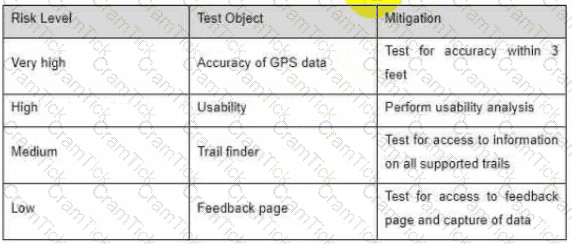
Your team has clone the depth and breadth testing for the GPS accuracy and usability features but when the product was given to beta testers there were some issues Despite the users reporting the app was easy to use at least one user walked off the edge of a cliff and another one ended up in a river. Your team has confirmed that the functionality is working correctly. and the GPS information is accurate.
What other area of testing should you now prioritize?
You are working for an outsource testing company You have a client that will only consider candidates that are highly skilled with Salesforce. regardless of the number of years they have spent testing similar products You have looked through your skills matrix and you have no one with the right type of experience for this project.
What competence area is your team lacking?
You have been assigned t o a project that has a very tight schedule. In fact, given your first analysis you do not think the planned test execution can be completed within the schedule There is no time allowed for defect fixing or for repeating tests. Regression testing has been left out of the planning entirely There is no time to develop test automation. The team has agreed that this Is not the way to run a project, yet they are stuck with the current schedule
Given this information what is the best way to proceed with the testing to try to meet the deadline with the best outcome1?
You tend to be conservative in your project estimations because you know how many things can go wrong and extend the schedule. You manager is not happy with your estimates and thinks you are being too negative with your numbers and not trying hard enough Which estimation method should you use to provide your manager with a positive' number while still also providing the number you think is more realistic?
You are working on a project that is having problems with regressions. With each release of software given to the test team. 50% of the defects found are actually regressions. To combat this you have decided to implement test automation. You have given your automation team the following goal
'Implement lest automation to automate 90% of the manual regression tests before the product release date.’’
Which of the following is likely an issue with this goal being defined as "SMART?
There is a debate in your organization about who can close a defect report The developers think they should be able to reject and close defects without any further steps The testers are not happy with this approach as they are afraid the rejections may go undetected and the developers may close something without understanding the real problem
How can this problem be rectified7
Your team has been given the following test objective Ensure that the users are happier with this version than they were with the last version?
What is wrong with the way this is defined?
Which of the following defect statistics will provide input to be used for improvement in the defect reporting process?
Which of the Mowing should be used to understand the context of testing within an organization?
You are a new lest manager in an organization You have been asked to assess the defect process to determine if there are any efficiency improvements that could be made that would reduce the cost of quality You have started digging through the defect Information What information would be most helpful for this investigation?
You are looking to Improve the efficiency of testing. The developers have been claiming that the majority of defect reports they receive are invalid either due to the test environment or because the tester did not follow the right steps In a standard defect management process where should you look for more information about these invalid defects?
Your team has been assigned to test a loyalty card program for a supermarket chain. Because this is a highly competitive market significant investment has been made to determine the shortcomings of the products offered by competitors While the feature sets are mostly the same, there is a wide variance In usability and performance and the users perceptions of these quality characteristics
Given only this information what test approach would be most appropriate?
You are working with a development team who have a CI/CD pipeline implemented. They want to integrate your team's existing test automation into the pipeline to augment their unit tests so they will have continuous testing. They have already determined that this is technically possible with the tool you are using but with require some changes to the test automation framework to integrate the results reporting
What will your team need to make this happen?
You are working on a project where the business part of the organization works traditionally with defined requirements, but the development team follows an Agile model Neither team plans to change their approach What is the proper name for this type of project approach''
You have been seeing a high number of rejections of defect reports The developers are complaining that they do not understand what the problem is. even though they have been supplied with screenshots. You have checked a number of the 'problem' defect reports and have not found any information that is missing. The descriptions are very detailed and include all the necessary information in a long descriptive paragraph.
What change should you recommend that should help with the developer s problems?
You have assembled the following cost of quality numbers 200 defects were found prior to release and 100 were found after.
Given this information what is the total cost of quality for this project?
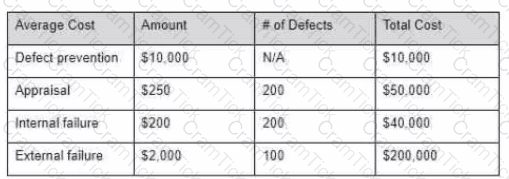
It the lest manager must repeatedly step in to resolve conflicts within the team what phase is the team in and what competencies are required from the test manager?
You have assembled the following cost of quality numbers 1 000 defects were found prior to release and 100 were found after.
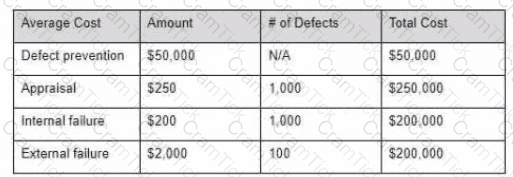
Given this information what should you conclude?
You are managing the testing for a bank card project. The testing was scheduled to take 10 weeks but by the time the software was developed only six weeks were available for testing Knowing there were a lot of risks with the software your team started testing activities early by overseeing code reviews, defining acceptance criteria by working with the users and by doing all lest creation prior to the code arriving
You are now three days away from the go-live date Your testing has mitigated all the high and medium risk items leaving only the low-risk elements unmitigated by testing You estimate it will take two weeks to manually test the low-risk elements At this point what should you do?
You have just conducted a skills assessment for your team. You decided to rate everyone from 1 to 5 in the skill areas as follows:
5 = expert
4 = proficient
3 = can use this skill effectively but will need some assistance
2 = interested in learning this skill but has only minimal knowledge
1 = not interested in learning this skill
Given these values, you have rated your team as shown in the table below for the designated skill areas:
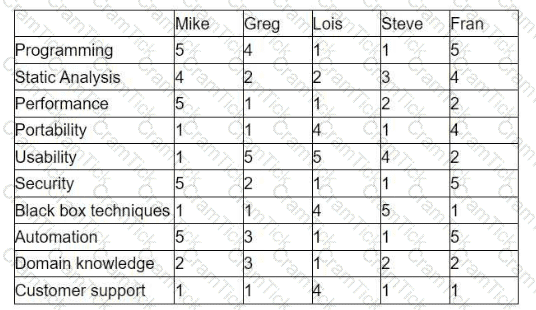
You will be starting to test a new product that is an upgrade from one of your existing end user products. Your testing will include white box,
performance, security, usability, and black box. You also have a goal to automate 100% of the smoke test and 50% of the regression tests by the end of the release.
Your team willingly shares knowledge and conducts regular lunch time cross-training sessions.
Your manager wants to know if you would like to bring in someone to help train your team in preparation for this project. In which area could
you best utilize this help? [3]


